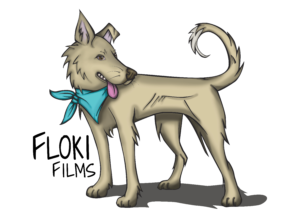
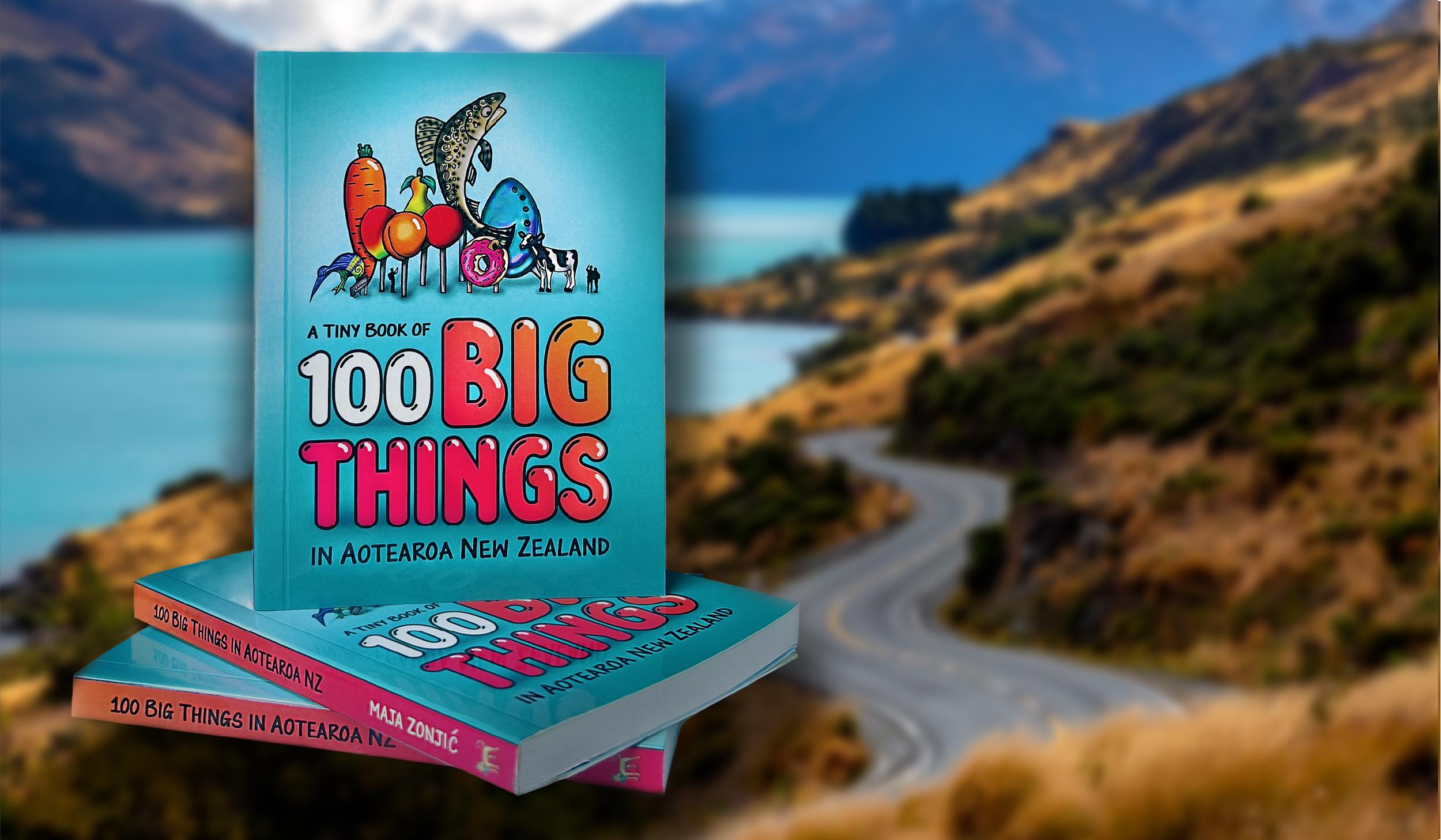
THE BOOK
Part tiny travel companion and part photobook, this is the first book of its kind to focus on Big Things – or large roadside structures – in Aotearoa New Zealand. Featuring the latest practical information, an illustrated fold-out map, and vibrant visuals throughout, it is an easy-to-follow guide for visiting Big Things across the country. The book emerges from the author’s long-term academic research project about Big Things locally, but is intended for a general audience. More information about the overall project will be uploaded later in the year.
THE KAUPAPA
This small booklet packs a big punch: 100% of the profits go towards creating scholarships for students in the social sciences and humanities! The scholarships are not tied to a specific tertiary institution. More information about scholarships will be made available on this site once the book profits reach $1,000. Each book sold generates a minimum of $5 profit towards the scholarships. Book profits are calculated by subtracting printing costs and retailers’ cuts (which support independent bookstores and local businesses!) from the book’s price. The book’s production is self-funded by the author through her media company.
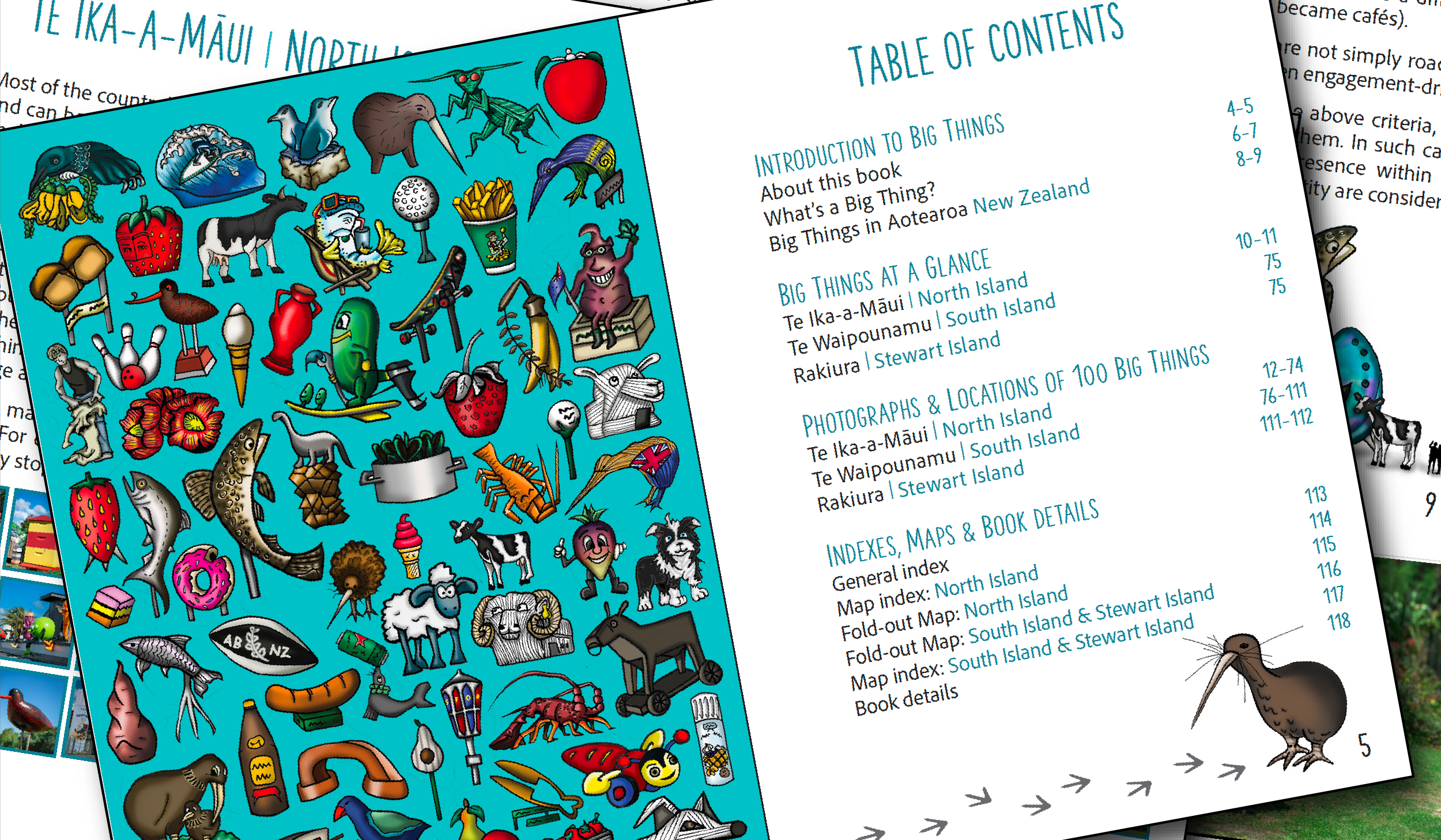
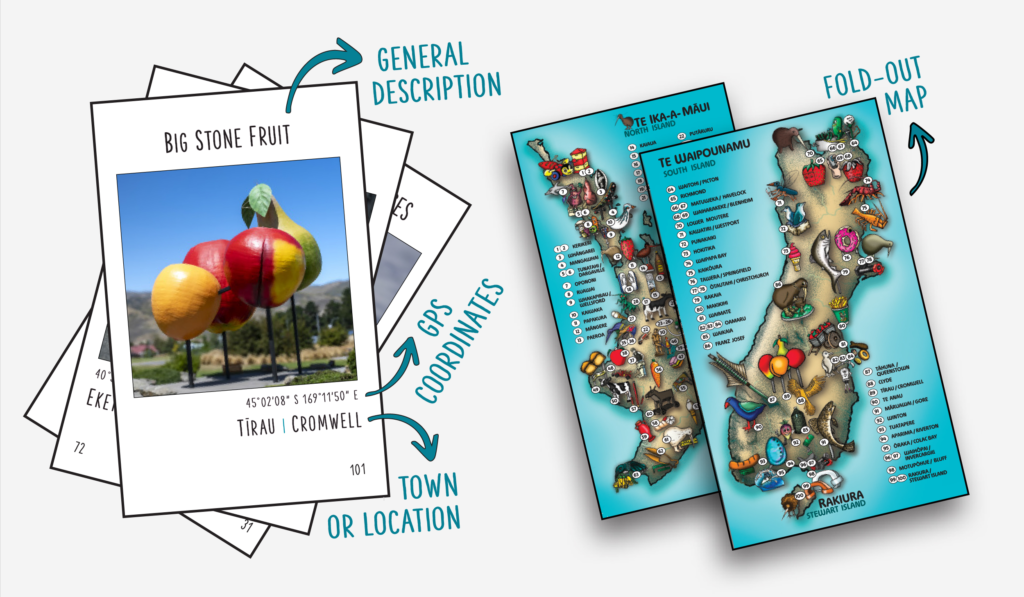
THE FEATURES
Each of the 100 Big Things has its own page, which includes the town/location name, GPS Coordinates, and access considerations. The book also provides some historical context about Big Things, and explains what characteristics distinguish a Big Thing from other roadside structures. The illustrated fold-out maps at the back of the book provide a quick reference for visually locating Big Things, while multiple indexes and at-a-glance sections enable easy book navigation.I
THE SPECS
ISBN: 978-0-473-75812-7
Publisher: Floki Films
Year of Publication: 2025
Size: 123mm x 91mm x 10mm; Weight: 108gm
Format: Paperback
Primary language: English
Genre: Travel Guidebook & Gifting/Novelty
Designed and printed in: Aotearoa New Zealand
Suggested retail price: $NZD 22 (GST inclusive)

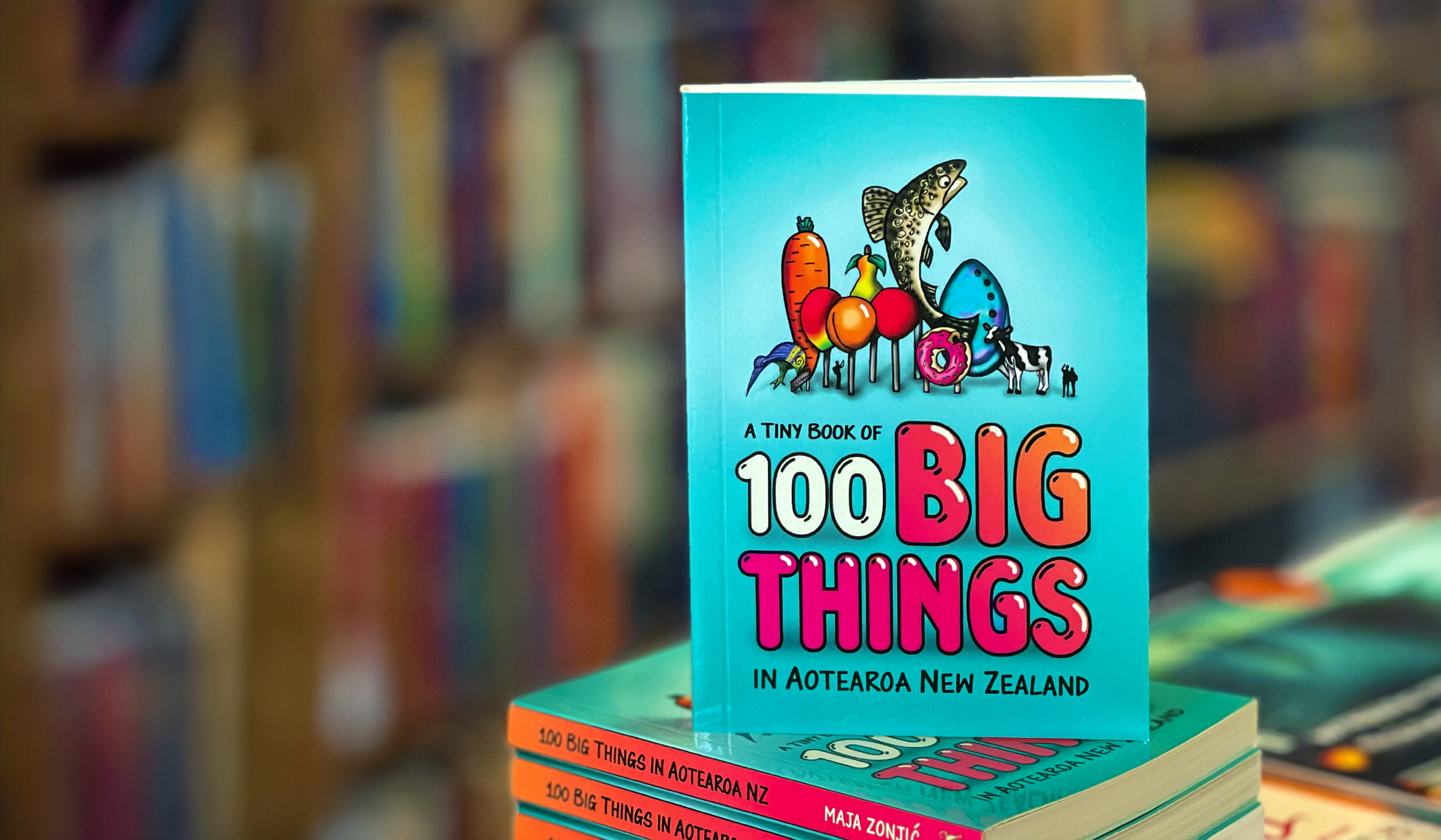
THE STOCKISTS
Check out BookHub for up-to-date information about book availability in store. Additional stockists will be added here over the next few weeks.
Schrödinger’s Books, 137 Jackson Street, Petone (Lower Hutt)
Unity Books, 57 Willis Street, Te Whanganui-a-Tara / Wellington
Marsden Books, 159 Karori Road, Te Whanganui-a-Tara / Wellington
Martinborough Books & Post, 6 Kitchener Street, Martinborough
Books & Co, 1/216 Main Haighway, Ōtaki
Scorpio Books, 120 Hereford Street, BNZ Centre, Ōtautahi / Christchurch
THE AUTHOR
Maja Zonjić is a Documentary storyteller and Cultural geographer, working as a Post-doctoral Research Fellow. She has exhibited and screened her documentary work internationally at galleries, museums, and film festivals, and has published her academic research in leading journals. Originally from Croatia, she speaks 3 languages; drinks too much coffee; regularly contributes to arts-based community kaupapa; and enjoys riding her motorbike around Te Whanganui-a-Tara / Wellington, where she lives.

FREQUENTLY ASKED QUESTIONS
How can I become a stockist?
Please get in touch by using the contact form, or email AotearoaBigThings [at] gmail [dot] com directly. I will then forward a book info sheet and sample pages for your consideration. Wholesale pricing is available for all stockists, and is in line with traditional profit margins for bookstores.
I run a tourism business / souvenir shop / arts store. Can I be a stockist?
Absolutely! International and national tourists have an interest in this book; both as a travel guide and a souvenir.
Is the content appropriate for kids?
Kids especially love this book because of its small size and fun, colourful graphics – but be mindful that small children may accidentally pull out the fold-out map at the back of the book. The content itself is appropriate for children of all ages.
Can I add your photos to my website? Or use them to make souvenirs?
All of the businesses with a Big Thing on their property are welcome to use the project’s photograph of their Big Thing for their own purposes – please get in touch for a high-resolution image! Photos should be credited as ©2025 Maja Zonjić / Aotearoa Big Things. Otherwise, the photos and film footage are not available for general use, and are copywritten. The copyright and moral rights for all project photos, film footage, as well as book contents (text; images; illustrations) are held by Maja Zonjić. They may not be used or reproduced without prior written permission by the author.
Is this really the first book that focuses on Big Things in the country?
Yes! A few previously published books included some Big Things in Aotearoa (usually, no more than a dozen structures), but those books’ primary focus was on Kiwiana or roadside and popular art more broadly. This is the first book, to the best of my knowledge and research ability, that explicitly focuses on Big Things here.
Are there exactly 100 Big Things in Aotearoa New Zealand?
100 Big Things are included in the book, but so far, through the archival research stage of the academic project (see questions below!), I have found 117 Big Things across the motu. And there will be more! They keep popping up every year, and there are parts of the country I have not travelled for the research.
What items are most commonly represented as Big Things?
Across all Big Things in the country, the most commonly represented ‘thing’ is a kiwi: there are nine kiwi bird Big Things across Aotearoa New Zealand! The second most commonly represented ‘thing’ is a golf ball -we have 7 of those- and the third is strawberries; with 5 Big Things. Overall, half of our Big Things are ‘things’ we eat and drink. Within the top 25 most well-known Big Things, 60% represent agricultural subject matter such as sheep, cows, and farming tools.
Is this book part of a wider academic research project?
This book emerges from an extensive three-year academic research project about Big Things locally. Broadly, the research examines whose and what stories are told by Big Things across the country, and suggests that despite their comical appearance which often results in them being discounted as frivolous artefacts of an outdated Kiwiana identity, Big Things have ongoing importance within evolving tourism, development, ideological, and political agendas across Aotearoa New Zealand at multiple scales.
There are two key phases to the research. This book in particular, stems from the first research phase that engaged archival work to catalogue all currently existing Big Thing structures in the country. At present, and despite Big Things being built for over 65 years here, no such archive exists. This project therefore, lays the foundation necessary for future Big Things research locally. It also contributes to emerging Big Things scholarship globally which highlights these structures’ importance and complexity within the context of national identity and local material culture. The second research phase, which considers specific Big Things and the stories they tell, is ongoing and only takes place in locations / rohe where I have close collaboration with mana whenua.
The academic research was funded by a Royal Society Te Apārangi Marsden Fast-Start grant (2023-2026). The overall project budget included funding for institutional overheads, partial salary, student scholarships, research assistant salary, research materials, and costs associated with fieldwork. The funding also partially supported the creation of some research outputs, although the costs of this book’s production – such as printing – are entirely self-funded. I wrote, photographed, designed, and illustrated the book on my own, and I am also doing the distribution and marketing.
Where can I find out more information about Big Things research?
Research for this project will be wrapping up in 2026. I will add more information about the research itself to this website later this year. Additionally, research outputs will take the form of both traditional academic publications and conference / seminar presentations, as well as publicly accessible community engagements and displays.
Are there any current publicly accessible research outputs other than the book?
Yes! Te Hīkoi Southern Journey museum in Aparima / Riverton is holding a long term photography exhibition of my work from late November to early May. The exhibition includes 100 photographs and a 10-minute documentary film loop. Check out their website to learn more about the museum.
Why does the kaupapa create scholarships for social sciences and humanities students?
I am very grateful to the Royal Society Te Apārangi and the Marsden Fund for enabling me to undertake the wider research from which this book stems. The Marsden Fund was the key funding mechanism for fundamental social sciences and humanities research in Aotearoa New Zealand. Last year however, the government completely cut humanities and social sciences research from being eligible for the Marsden Fund; effectively removing research funding pathways for dozens of disciplines including: social, cultural, and human geography; education; social, developmental, organisational, community and health psychology; public health; nursing; sociology; social anthropology; urban design and environmental studies; Māori studies; Indigenous studies; socio-linguistics; architecture; public policy; political science; English; film; languages; religion; philosophy; classics; art history; media studies; law; and history. You can read more about the impacts of the funding cuts and the critical importance of social sciences and humanities here, here, here, and here.
Many of my students – who are bright, innovative, critical thinkers with a shared commitment to justice and building a world where everyone can thrive – were also impacted by the cuts. They lost opportunities to apply for new Postgraduate and Summer Scholarships. Their ability to earn money and develop skills that would make them more competitive for other scholarships and the job market through Research Assistant work also decreased. Research funding benefits entire teams of people; not to mention local businesses where fieldwork takes place, and where research materials are purchased.
Having been funded through a Marsden Fast-Start grant, my project also got imbricated into the wider discourses about research funding at the end of last year: scholarship about Big Things leads to derision precisely because these structures are widely recognisable within the national imaginary and appear frivolous on the surface. Big Things also make excellent media article headlines and lead photographs as clickbait. They have the effect of completely overtaking the narrative; not unlike the effect they have within the places they are installed. This was in fact, one of my key suggestions back in 2022 when I applied for the Marsden Fast-Start grant.
Through my research, I also found that Big Things are important to regional economies – many of which are currently struggling, and developing initiatives to attract more visitors. Simultaneously, I’ve spoken to hundreds of people while on fieldwork, and many indicated their interest in a small Big Things photobook. I had already taken all of the photographs necessary having completed the archival research phase, and I wanted this project to contribute towards a community kaupapa outside of my formal research outputs. So, A Tiny Book of 100 Big Things in Aotearoa New Zealand, was born! The book supports local businesses and Independent bookstores that stock it; encourages travellers to stop by small towns they may not otherwise have planned on going; and it creates a little bit of revenue for students in social sciences and humanities to let them know their studies are important, and to encourage them to keep going.
CONTACT
Check out the FAQ section for answers to commonly asked questions. If your query is not answered above, get in touch by using the form below. If you are interested in becoming a stockist, have a media request, or would like to place a larger international order, also please use this form.
